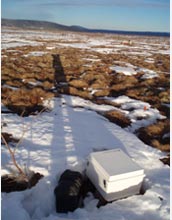Multimedia Gallery
Radiocarbon dating was used to detect the loss of old soil carbon at this Alaskan research site.
Twice as much carbon is contained in the soils and permafrost of northern ecosystems compared to the atmosphere. Because of the size and nature of the permafrost carbon pool, decomposition of previously frozen, old organic carbon is one of the most likely positive feedbacks to climate change in a warmer world. Under the direction of Ted Schuur of the University of Florida, this research used radiocarbon dating to detect the loss of old soil carbon in combination with an ecosystem-scale field manipulation to study factors that affect the release of permafrost carbon. These measurements helped quantify the lateral movement of carbon from tundra ecosystems experiencing permafrost thaw, allowing researchers to estimate the overall loss of carbon from these ecosystems.
Credit: Ted Schuur
Images credited to the National Science Foundation, a federal agency, are in the public domain. The images were created by employees of the United States Government as part of their official duties or prepared by contractors as "works for hire" for NSF. You may freely use NSF-credited images and, at your discretion, credit NSF with a "Courtesy: National Science Foundation" notation.
Additional information about general usage can be found in Conditions.
Also Available:
Download the high-resolution JPG version of the image. (3.8 MB)
Use your mouse to right-click (Mac users may need to Ctrl-click) the link above and choose the option that will save the file or target to your computer.
Related story: Arctic Tundra May Contribute to Warmer World



